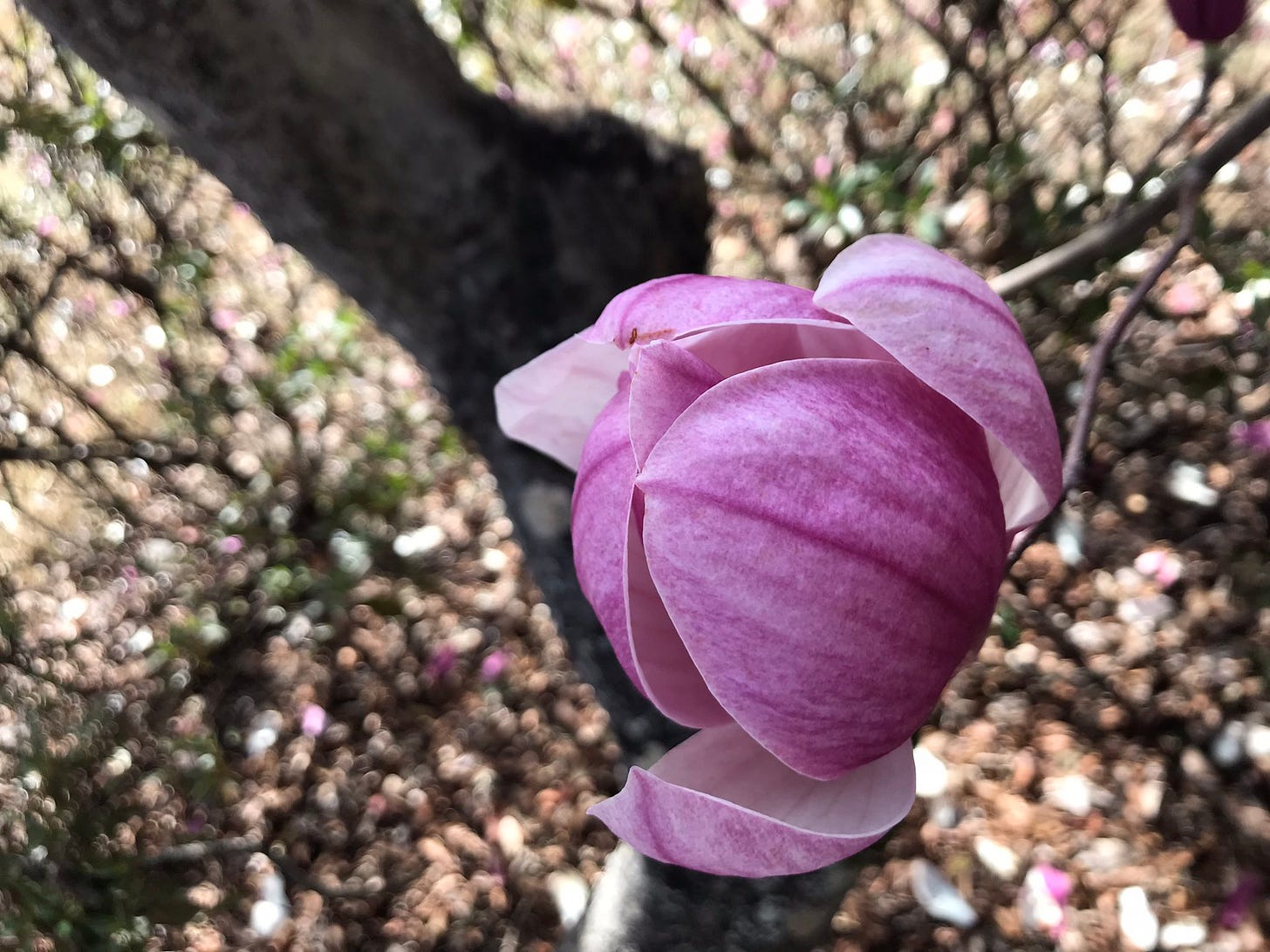Welcome to the inaugural issue of Tiny Goat! For those of you who’ve come over from my creativity column, thank you. For those of you who found me another way, it’s very nice to meet you.
So what are we doing here, exactly? Every couple of weeks, I’ll send you a post like this, with a short and (hopefully) thought-provoking essay about a topic or trend relevant to the eco art world. I’ll also offer additional links to music, articles, videos, virtual events, and more, to help you delve a little deeper into current environmental science, nature-inspired art, and creative climate action.
Let’s get started.
Want to relax? Try sniffing rain-soaked dirt
In central Alabama, where I’m based, spring typically gets off to an erratic start, and this year is no exception. Our first bout of warming tricked the saucer magnolias in my yard to burst into cheery purple bloom two weeks ago, but thankfully most other flowers knew better. Because sure enough, we plunged back down below freezing for a night, and all those early-bird blooms wilted away in shock.
Now, though, we’re in the midst of a record-setting warm streak in the Southeast, with 80-degree temperatures happening almost three weeks ahead of average. It’s taken several years for my Midwestern body to learn to treat February heat with trepidation rather than joy, since weather like this often means tornados are on the horizon. Yet despite the fact that I know rain means heightened risk, I can’t help but still love the smell of it.
Turns out, there’s a scientific reason for this attraction to petrichor, the earthy-sweet scent of soil after a recent rain. I recently picked up Lucy Jones’s Losing Eden: Our Fundamental Need for the Natural World and Its Ability to Heal Body and Soul, which surveys studies from a wide range of disciplines in search of a deeper understanding of how, exactly, contact with nature benefits human bodies and minds. “In 2007, chemists at Brown University discovered the organic compound responsible for [petrichor], which is more pronounced after it has rained. It is called geosmin,” Jones writes, adding that humans are highly sensitive to the smell of geosmin and can detect remarkably low concentrations of it in a particular patch of soil.
According to Jones, early studies are showing that contact with geosmin stimulates brainwaves associated with relaxation and calmness, especially in women. It’s not yet clear why, exactly, this happens, but these scientific observations track with what gardeners have always known: contact with soil just makes you feel better.
Similarly, University of Ohio Extension soil scientist Jim Hoorman says evidence is growing that geosmin boosts serotonin and norepinephrine in the brain similarly to antidepressants. “Rain on healthy soils may decrease stress and improve your mood by 60 percent … That’s why a good rain can be so refreshing to human mental health and is related to healthy soil microbes,” he writes.
This probably explains why so many gardeners are, like me, perennially drawn to starting their first batches of seeds a little too soon, like an overly optimistic magnolia bloom. My winter-weary mind is eager for the season’s first “hit” of geosmin, and I’m making all sorts of excuses to start working in my empty garden beds between thunderstorms. And yes, I may have personally sacrificed a few unlucky tomato seedlings to the cause of my own happiness—but with temperatures like what I’m experiencing this week, who, truly, could resist the urge to “put a few out there, just to see what happens?”
Listen
Candace Coker is a Trinidad-born folk singer. She “began songwriting as a purely therapeutic exercise, crafting melancholy folk melodies that put sound and language to her emotions, created space for conversations with God and provided stillness for her anxious mind to rest.” She also happened to give one of her songs the perfect title for this week’s issue of Tiny Goat.
Two more thought-provokers
The Guardian, The Hagrila Army: “A group of rural women in the Indian state of Assam are working to protect one of the world’s rarest storks: the greater adjutant—or hargila (meaning ‘bone swallower’ in Assamese) as the scavenger bird is known locally.”
The Public Domain Review, A Bestiary of Loss: “Humans might be unparalleled predators, but recent extinctions demonstrate how our deadliest weapon is the forms of collective behavior that economic, political, and social life enshrine.”
Dig Deeper
After reading Losing Eden, I googled Jones and found this remarkable conversation between her and the renowned scientist-writer Robin Wall Kimmerer, author of the pathbreaking Braiding Sweetgrass. (I had the great fortune to interview Kimmerer last month for a freelance piece coming out this summer, so stay tuned for more about her in an upcoming issue of this newsletter.)
If you have some time to spare, I highly encourage you to listen to these two giants in contemporary eco writing discuss their ideas about rebuilding connections between humans and nature:
One Last Thing
“Risk” by Anaïs Nin
And then the day came,
when the risk
to remain tight
in a bud
was more painful
than the risk
it took
to blossom.
Stay Connected
Thank you, sincerely, for reading the first issue of Tiny Goat. I’m excited to see where this project evolves in the coming months, and I’m so glad you’ve decided to follow along. If you haven’t yet, please subscribe below. I also invite you to check out the Tiny Goat Bookshop, an official Bookshop.org affiliate. (I’m required to tell you here that I make a small commission if you choose to purchase through my shop.)
Tiny Goat is a collaboration between Sandra Barnidge and her very talented (and very private) younger brother. We might develop dedicated Tiny Goat social handles over time, but for now, you can follow Sandra to stay in touch with us.




